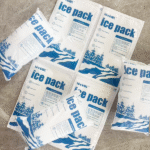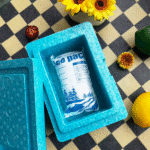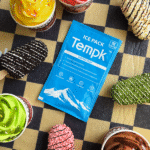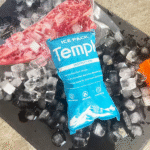In the fast-paced world of cold chain logistics, ensuring that frozen food reaches its destination at the right temperature is critical for maintaining product quality and safety. One of the most effective solutions is the use of dry ice pack sheets, which offer unparalleled benefits over traditional cooling methods. These sheets not only provide long-lasting cooling but also ensure that your products remain in perfect condition during transit. In this article, we’ll explore how dry ice pack sheets work, their advantages, and how to use them effectively in your shipping processes.
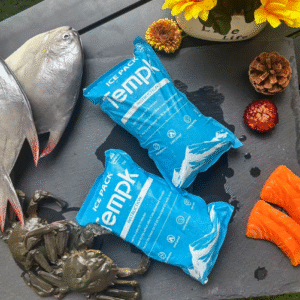
What Are Frozen Food Dry Ice Pack Sheets?
Frozen food dry ice pack sheets are flexible cooling agents made of solidified carbon dioxide (CO2) that sublimate directly from solid to gas at -78.5°C (-109.3°F). This sublimation process is what makes them so effective in maintaining low temperatures during shipping. Unlike traditional ice or gel packs, dry ice leaves no liquid residue, preventing water damage to sensitive food products such as seafood, meats, and desserts.
These sheets are highly customizable and can be cut to fit various container sizes and shapes, providing a snug and efficient cooling solution. The flexibility of dry ice pack sheets also allows them to conform to the shape of the products being shipped, making them a versatile option for businesses in the frozen food industry.
How Do Dry Ice Pack Sheets Work in Cold Chain Logistics?
Dry ice pack sheets provide a unique cooling mechanism through the sublimation process. Here’s how they work:
-
Sublimation Process: As dry ice sublimates, it absorbs heat from its surroundings, creating a cooling effect that can last for up to 72 hours. This is much longer than traditional gel or ice packs, which only maintain cool temperatures for 12-24 hours.
-
Long-lasting Cooling Effect: Unlike water-based cooling systems, dry ice pack sheets ensure that the cooling process is free from any liquid residue, making them ideal for shipping frozen food and pharmaceutical products that require ultra-low temperatures.
-
Cost-effective and Sustainable: Many dry ice sheets are reusable, offering a sustainable and cost-effective solution. Reusing sheets reduces waste and lowers the overall cost of shipping.
-
Customizable for Different Products: Dry ice pack sheets can be cut to fit any size or shape, ensuring the products are kept at the required temperature without wasting materials.
Benefits of Using Dry Ice Pack Sheets for Frozen Food Shipping
Frozen food shipments must meet strict temperature regulations, and dry ice pack sheets offer several key advantages:
1. Maintains Product Quality
Dry ice sheets ensure that products like frozen meats, seafood, and ice cream remain at the desired temperature throughout transit. By preventing thawing, these sheets help preserve the integrity and texture of perishable goods, reducing spoilage and waste.
2. Extended Shelf Life
By keeping products frozen for extended periods, dry ice sheets prevent bacterial growth and the risk of foodborne pathogens, ultimately increasing the shelf life of the items.
3. Environmentally Friendly
Since dry ice is made from carbon dioxide (CO2), a naturally occurring substance, it doesn’t leave behind harmful residue or contribute to environmental pollution. This makes dry ice an eco-friendly option for cold chain logistics.
4. Flexibility in Handling
Dry ice pack sheets are flexible, enabling them to fit snugly into containers, maximizing space and ensuring even distribution of cooling. This feature is particularly beneficial when shipping products of varying shapes and sizes.
How to Choose the Right Dry Ice Pack Sheets for Your Shipping Needs
Selecting the right dry ice pack sheets involves considering several factors to ensure optimal performance:
-
Size and Shape of Shipments
Dry ice sheets are customizable, so it’s essential to choose the right size for your shipment. The sheets can be cut to fit different shapes and sizes of products, providing complete coverage. -
Duration of the Trip
The duration of the shipping journey directly affects the amount of dry ice required. For longer trips, thicker or larger sheets are needed to maintain the cold temperatures. -
Storage and Handling
If your business requires long-term storage of dry ice, opt for reusable sheets or those with gel-based refrigerants, which can be recharged and reused multiple times.
Best Practices for Shipping Frozen Foods with Dry Ice
When using dry ice pack sheets, there are several best practices to follow to ensure safe and efficient shipping:
1. Proper Packaging and Insulation
Use insulated containers to minimize heat transfer from the external environment, enhancing the effectiveness of dry ice pack sheets. Proper insulation ensures that the cooling effect lasts longer.
2. Follow Safety Regulations
Dry ice is classified as a hazardous material, so ensure that you follow all relevant safety guidelines, including proper labeling, ventilation, and protective gear for handling.
3. Monitor Temperature
Monitor the temperature of the shipment throughout its journey using temperature sensors or data loggers. This will ensure that your products stay within the required temperature range.
2025 Trends and Innovations in Frozen Food Shipping
The frozen food shipping industry is constantly evolving. Some of the latest trends and innovations include:
Sustainable Alternatives to Dry Ice
As sustainability becomes a key focus in logistics, many companies are exploring eco-friendly alternatives to dry ice, such as bio-based refrigerants and phase change materials (PCMs).
IoT Integration in Cold Chain Logistics
Real-time monitoring systems powered by the Internet of Things (IoT) enable businesses to track temperature, humidity, and other critical factors, reducing spoilage and improving efficiency.
Hybrid Cooling Solutions
Hybrid systems combining dry ice and PCMs offer a balanced solution, providing ultra-cold temperatures at the start of the shipment and maintaining stable conditions throughout the journey.
FAQ
What is the difference between dry ice pack sheets and regular dry ice?
Dry ice pack sheets are flexible and designed for easy handling, whereas regular dry ice is solid and typically comes in blocks or pellets. Dry ice pack sheets are ideal for keeping frozen food at ultra-low temperatures without leaving any liquid residue.
How long can dry ice pack sheets keep my frozen food cold?
Dry ice pack sheets can maintain temperatures for up to 72 hours, depending on the size and insulation of the container, making them perfect for long-distance shipping.
Conclusion and Recommendations
Dry ice pack sheets are an invaluable tool in ensuring the safe and efficient shipping of frozen foods. They provide long-lasting cooling, are environmentally friendly, and help preserve the quality of perishable goods. By choosing the right dry ice pack sheets and following best practices, businesses can reduce spoilage, enhance customer satisfaction, and comply with regulatory requirements.
Next Steps:
-
Evaluate your shipment needs and determine the appropriate dry ice pack sheet size based on the payload and journey duration.
-
Follow best practices for packaging and safety to ensure your frozen foods stay within the required temperature range.
-
Stay updated on new trends and innovations in cold chain logistics to maintain a competitive edge in the market.
About Tempk
Tempk is a leader in providing high-quality dry ice solutions for cold chain logistics. Our products are designed to meet the stringent requirements of the food industry, ensuring that your frozen goods remain in optimal condition from start to finish.
Call to Action:
Contact Tempk today for tailored solutions to optimize your frozen food shipping process with dry ice pack sheets.
















